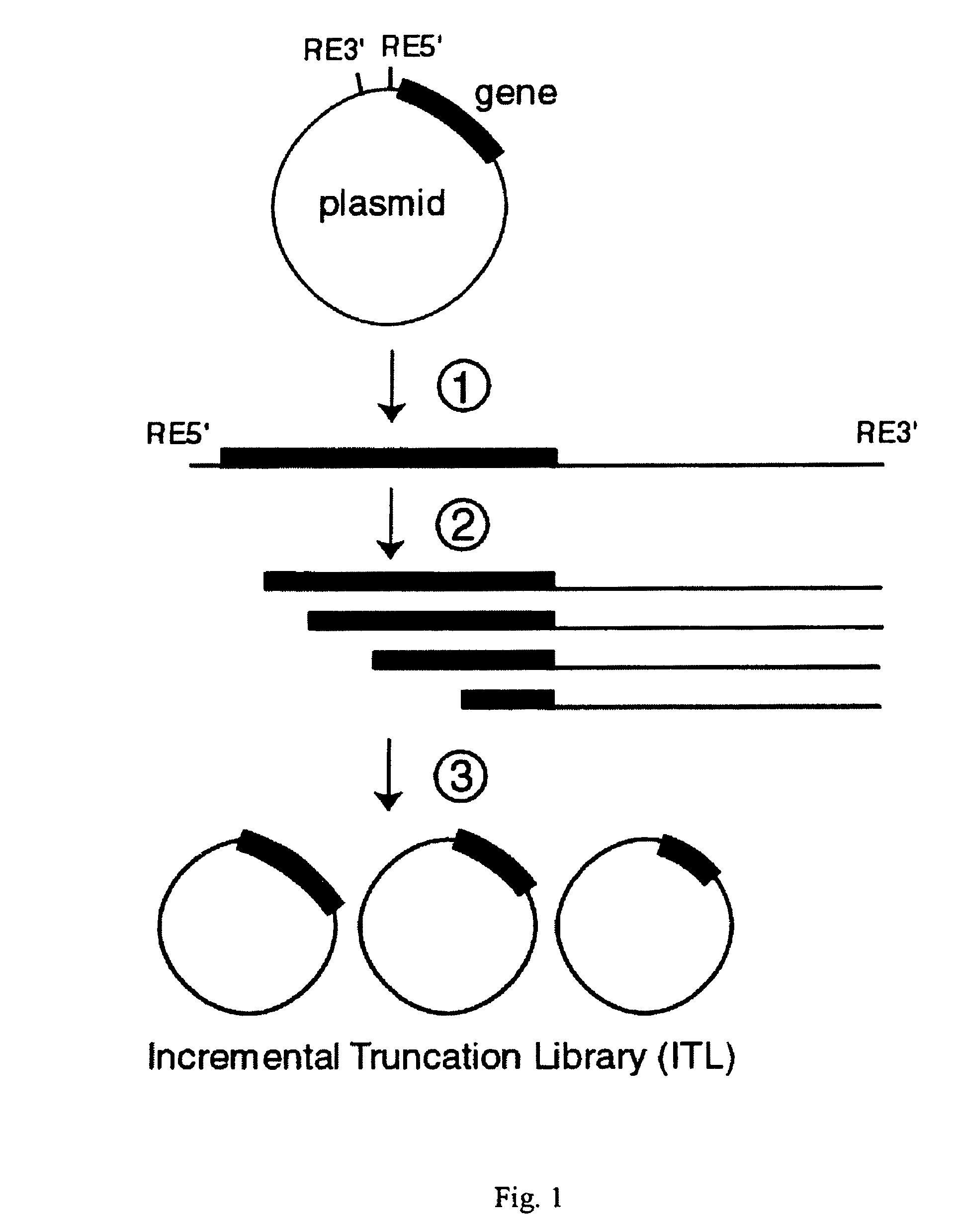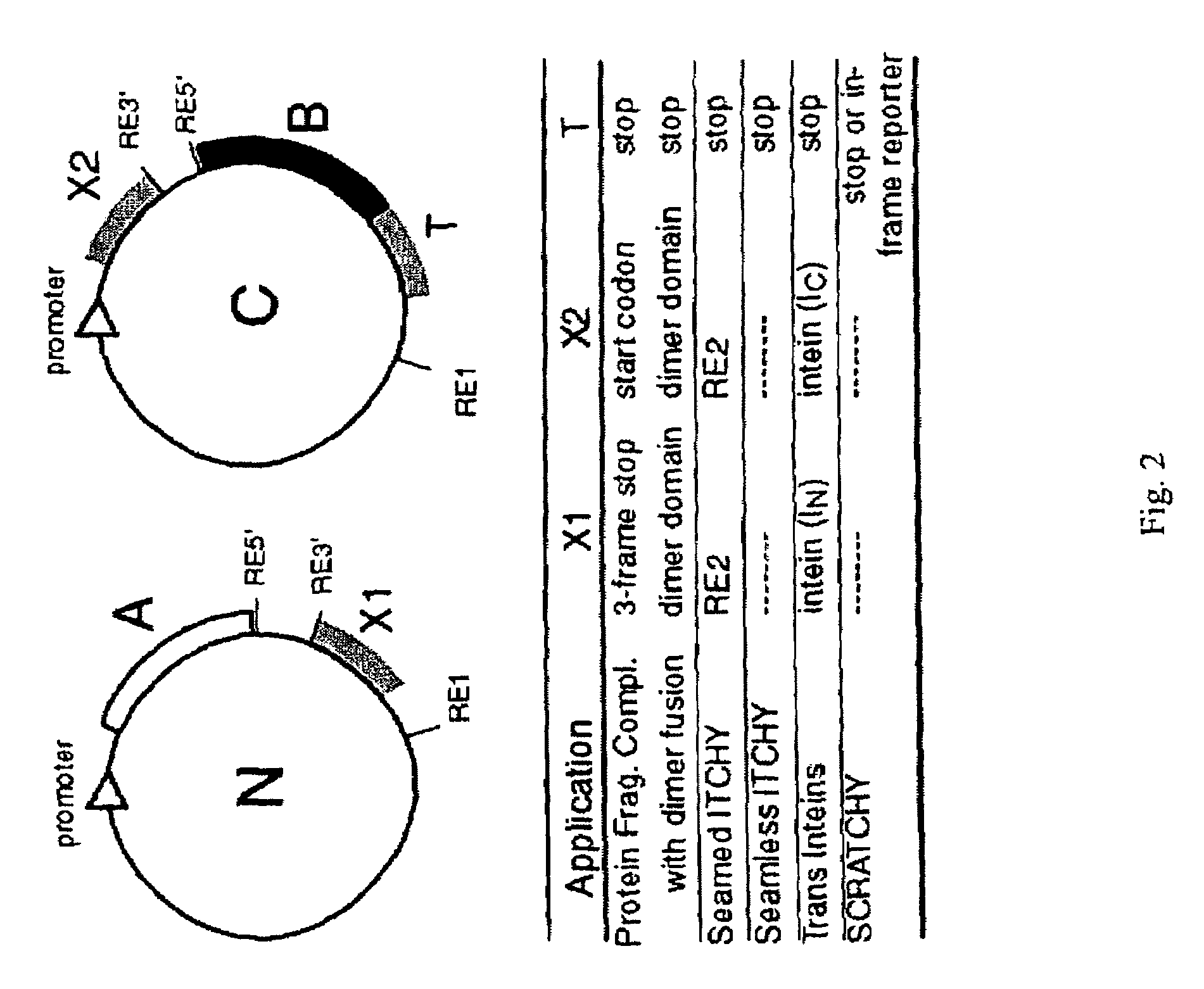Incrementally truncated nucleic acids and methods of making same
a nucleic acid and truncated technology, applied in the field of nucleic acid and polypeptide mixtures, can solve the problems of large sequence space excursions, unstable proteins, and inability to fold properly, and achieve the effects of reducing the number of steps in sequence space, reducing the utility of current directed evolution methodologies, and presumably requiring large sequence space excursions
- Summary
- Abstract
- Description
- Claims
- Application Information
AI Technical Summary
Problems solved by technology
Method used
Image
Examples
example 1
Protein Fragment Complementation by Incremental Truncation
[0214]Two overlapping fragments of the E. coli purN gene (which encodes glycinamide ribonucleotide formyltransferase) were cloned into compatible vectors pDIM-N2 and pDIM-C6. The N-terminus fragment (purN[1-144]) consists of the DNA coding for residues 1-144 and the C-terminus fragment (purN[63-212]) consists of the DNA coding for residues 63-212.
[0215]Phagemids pDIM-N2 and pDIM-C6 were constructed by a series of oligo replacements into vectors pMOpelB.H and pMOpelB.L designed for creating very large Fab antibody libraries. These antibody vectors were derived from pBP107 (Posner et al., Gene 128:111-117 (1993)) and pTC01 (Collet et al., Proc. Natl. Acad. Sci. USA 89:10026-10030 (1992)), respectively.
[0216]Two micrograms of PstI / XbaI-digested pDIM-N2 or SacI / XhoI-digested pDIM-C6 were equilibrated at 12° C. in 60 microliters of 66 millimolar Tris, pH 8.0 / 0.66 millimolar MgCl2. At time zero, 200 units of exonuclease III were ad...
example 2
Incremental Truncation for the Creation of Hybrid Enzymes
[0224]Phagemids pDIM-N2 and pDIM-C6 are described elsewhere herein. Phagemid pDIM-C8 is identical to pDIM-C6 except for the substitution of a BglII site for the BamHI site and the substitution of a NsiI site for a PstI site 10 base pairs downstream from the SpeI site.
[0225]Incremental Truncation:
[0226]Incremental truncation was performed essentially as described above in Example 1, with the following modifications. Supercoiled pDIM-N2 and pDIM-C8 were linearized by digestion with XbaI / PstI and SacI / XhoI, respectively. The Exo III digestion was performed at 22° C. in 60 microliters of 66 millimolar Tris (pH 8.0), 0.66 millimolar MgCl2, 100 millimolar NaCl. After inactivation of Exo III and S1 nuclease, the ethanol-precipitated DNA was resuspended in 70 microliters of water. After the addition of 10 microliters of 0.125 micromolar each dNTP, 2.5 units of Klenow fragment (in 2 millimolar Tris.HCl, 10 millimolar MgCl2, pH 8.0) wer...
example 3
Creation of a Circular Permuted Incremental Truncation Hybrid Library
[0232]Materials and Methods
[0233]All enzymes used were from New England Biolabs (Beverley, Mass.) unless otherwise indicated.
[0234]Plasmid Constructs:
[0235]Phagemid pDIM-N5 was created by replacing the short BamHI-NsiI fragment of pDIM-N2 with an oligonucleotide as described in FIG. 9. Phagemid pDIM-N-5-PurN[1-202*] / GART[20-203] contains a fragment of the E. coli purN gene that encodes amino acid residues 1-202 (with the mutation D144A) between the NdeI and BamHI sites of pDIM-N5 and a fragment of the human GART gene that encodes amino acid residues 20-203 between the BglII and SpeI sites of pDIM-N5. The vector has a stop codon between codon 202 of purN and the BamHI site.
[0236]Creation of the Circularly Permuted Insert:
[0237]A 528 basepair fragment of the E. coli purK gene was amplified by PCR using oligos Xba-for
[0238]
(SEQ ID NO:1)(5′-TTAGGCCGTCTAGAGCGTCAGGCAGGCGAACCG-3′)andXba-528(SEQ ID NO:2)(5′-GCGGAAAATCTAGAC...
PUM
| Property | Measurement | Unit |
|---|---|---|
| pH | aaaaa | aaaaa |
| volume | aaaaa | aaaaa |
| pH | aaaaa | aaaaa |
Abstract
Description
Claims
Application Information
 Login to View More
Login to View More - R&D
- Intellectual Property
- Life Sciences
- Materials
- Tech Scout
- Unparalleled Data Quality
- Higher Quality Content
- 60% Fewer Hallucinations
Browse by: Latest US Patents, China's latest patents, Technical Efficacy Thesaurus, Application Domain, Technology Topic, Popular Technical Reports.
© 2025 PatSnap. All rights reserved.Legal|Privacy policy|Modern Slavery Act Transparency Statement|Sitemap|About US| Contact US: help@patsnap.com



